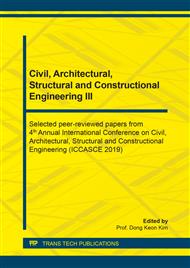p.195
p.202
p.211
p.221
p.226
p.231
p.239
p.245
p.250
Framework for Sustainable Procurement - Identifying Elements for Construction Works
Abstract:
Sustainable procurement has been considered an opportunity for improving the environmental performance of the construction industry. The development of sustainable procurement in Indonesia is still in its initial phase. Therefore, a framework is needed to establish an outlook to explore the enablers and barriers for promoting sustainable procurement in the construction industry. In the formulation of the framework, the first step is to identify the important elements. The approach was explorative-descriptive. Based on ISO 20400, as the guidelines for sustainable procurement, and literature on sustainable procurement for construction works, a list of elements was gathered. In-depth interviews were conducted to identify the most significant elements for the Indonesian construction public procurement context. Respondents included procurement experts from the government agency, (i.e., the National Public Procurement Agency and the Ministry of Public Works and Housing), academics, and procurement specialists who are the members of the Indonesian Procurement Professionals Association. Results suggest that all elements contained in ISO 20400 are relevant with the kinds of literature on construction works; also, Indonesian respondents agreed with all the identified elements ranging from “important” to “very important.” This finding will be subsequently used to further understand the complex cause-effect relationships among the important elements in developing the framework for sustainable construction public procurement.
Info:
Periodical:
Pages:
245-249
Citation:
Online since:
April 2020
Authors:
Keywords:
Price:
Сopyright:
© 2020 Trans Tech Publications Ltd. All Rights Reserved
Share:
Citation:


